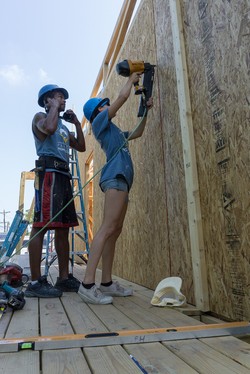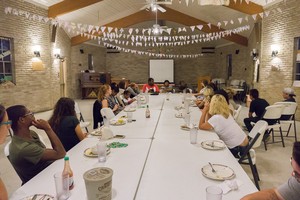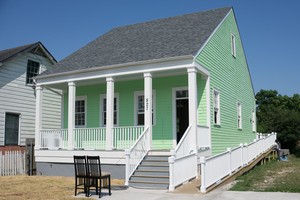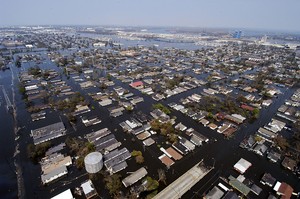The numbers surrounding Hurricane Katrina are staggering, almost unimaginable.
The Aug. 28, 2005 hurricane is responsible for 1,833 deaths. More than half of the people who died in Louisiana were 65-years-old and over. Forty percent of them drowned. More than 134,000 homes in New Orleans—70 percent of occupied units—were damaged or destroyed. Total damages are estimated at $135 billion. More than a million people were displaced from their Gulf Coast homes, over 250,000 from New Orleans alone—half the city’s population.
Less than a month later, when residents were finally returning to sift through the rubble and mayhem of what remained of their lives and belongings, Hurricane Rita hit the region adding 120 people to the death toll and another $15 billion in damages.
For many it has been too much. The immense human, housing and economic costs of these storms, along with a sense of despair felt at the slow response of federal agencies to help those affected, has kept at least 100,000 people from returning to New Orleans, a quarter million to the region.
City and state officials readily admit the long and patient work of recovery wouldn’t have been possible without assistance from the faith community. Project Homecoming, one of dozens of faith-based relief groups, was on the scene almost immediately to provide emergency provisions and begin the long process of rebuilding homes and lives.

Workforce development member, Aaron Franklin-White, and French volunteer, Claire, complete the exterior of a newly constructed home. —Gregg Brekke
The organization wasn’t called Project Homecoming at first. In the desperate days following the storm, little, if anything, could be called organized. The Presbytery of South Louisiana joined with residents and members of Presbyterian Disaster Assistance emergency response teams to assess the most urgent needs.
The Rev. Jean Marie Peacock, founder of Project Homecoming, returned to pastoral and community ministry in the New Orleans area in April, though she remains involved with the project through the presbytery. She recalls the early days of the organization and the collaborative caring that took place with area churches—many which needed rehabilitation—and PDA volunteers.
“We didn’t have the structure in place to utilize volunteers in the construction and rehab of homes,” she says of the early relief efforts that took place in 2006. “All the churches that had been hosting volunteers came together to envision what the construction management would look like.”
“We opened our doors in April 2007,” she remembers, saying the first incarnation of Project Homecoming was intended to manage construction projects while host churches were tasked with volunteer arrangements.
“We didn’t do much publicity, and we were doing a small ribbon cutting ceremony with partners including city representatives, Catholic Charities, PDA, our presbytery and FEMA folks,” she says. “There were a ton of people there for the opening and ribbon cutting—we even had a nice little cake—and there was huge line of people thinking we were ready for them. We hadn’t even set up the intake forms yet; it was overwhelming.”
Undeterred, Peacock wrote a makeshift form on scrap paper and made photocopies to hand out to the crowd who had been waiting in the rain for hours.
“That’s kind of the madhouse of how it started,” she laughs. “We were always trying to catch up after the storm. We had over 300 applications in those first few days and we had to stop taking new applications. Although we couldn’t help everyone, we took the cases we could work on and referred the others. All 300 applicants started to receive assistance that first year.”

Community night dinner at Project Homecoming's Volunteer Village is followed by a visit by a homeowner helped by the organization. —Gregg Brekke
More than 11,000 volunteers have given a week of their time to Project Homecoming efforts—that’s around $9.6 million in donated labor. Through their efforts, 240 homes have been built or re-built and many families have returned home.
Project Homecoming became an independent non-profit corporation in 2011 and ended its official relationship with PDA the following year. Still a ministry of the South Louisiana Presbytery, the organization continues the massive task of rebuilding and rehabilitating homes with volunteers, largely funded by grants and donations.
Kris Pottharst, Project Homecoming’s director since April, came to the organization after working with non-profit groups addressing early childhood education. She’s excited for Project Homecoming’s future and its ability to address a variety of needs in the community.
“As I worked on various ways to help the early-childhood vulnerable community in New Orleans it became really clear to me it’s not just about childcare, not just working on preschool,” she says. “You have to stabilize the family before you can have really affected their chances in life. And what is one big huge thing? Housing.”
Pottharst says the city estimates there are 7,600 homes out of compliance with criteria established by the Road Home rebuilding program. It’s only six percent of the 130,000 homes that received federal funding, but she says funds for rebuilding aren’t as readily available, so Project Homecoming has diversified in order to continue its work.

A newly constructed home in New Orleans’ Lower Ninth Ward neighborhood, built to historic preservation standards, is painted by a Project Homecoming workforce crew. —Gregg Brekke
In addition to having a full-time liaison to help people resolve compliance and contractor fraud issues, Project Homecoming has started an affordable rental program, home construction and sales for low income buyers, and a workforce development program.
Pottharst sees these new revenue generating opportunities as a means to continue the organization’s main mission—providing quality housing for New Orleans residents, regardless of their income level.
“Twenty-seven percent of New Orleans residents are paying more than 50 percent of their income for housing,” she says of the recent spike in home values and rent. “That’s too much.”
Along with creative programs aimed at providing affordable new or rehabilitated housing, Project Homecoming, Pottharst says, prides itself on the high quality and long-term cost efficiency of its construction.
“We do very good construction,” she says. “When we’re talking about having or rebuilding a house, we are making it storm resistant, and we’re making it energy efficient to the max. [Low income buyers] could get clobbered by utility bills—nobody is factoring that into what you can afford. So our homes are typically 40 percent more efficient than another newly built home, which is $3,000 per year.”
“What will always be here is a need for affordable, sustainable housing,” says Kevin Krejci, Project Homecoming’s deputy director. “While project homecoming was born out of Hurricane Katrina, and born out of the Presbyterian Church, it’s put down roots in this community where it hopes to have a long-term impact on the community as long as there’s a housing need in New Orleans.”
-----
Two videos on Project Homecoming’s work are available at the following links:

